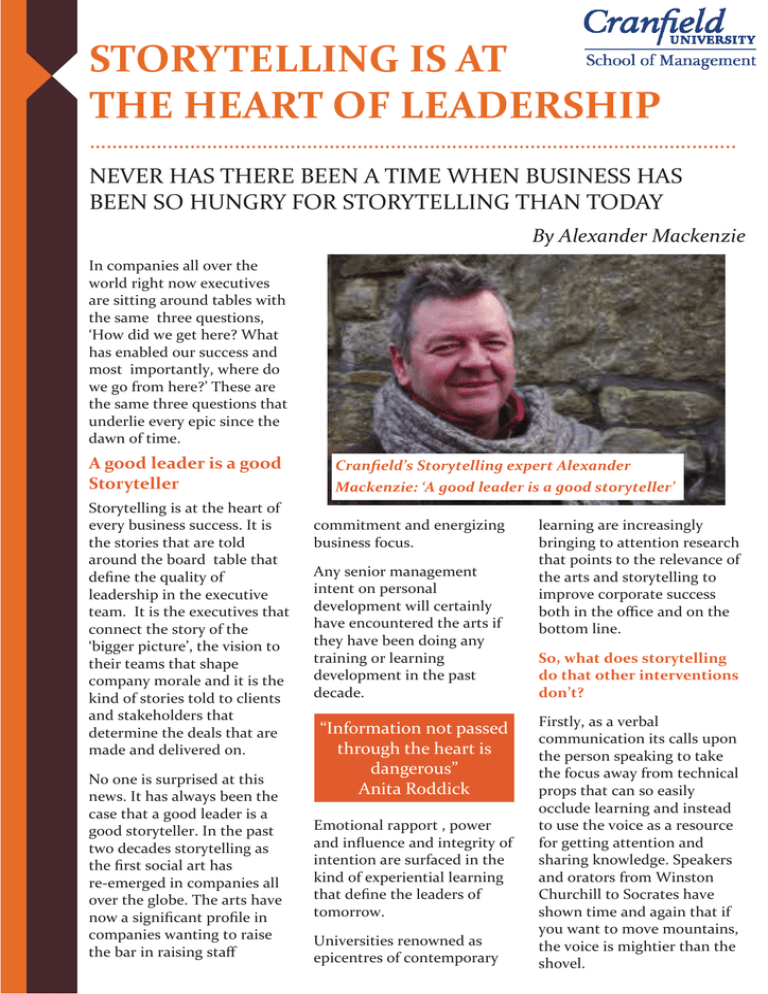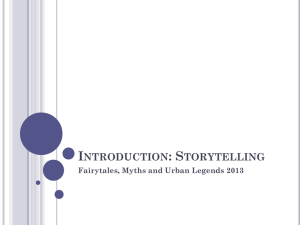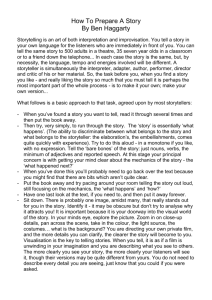STORYTELLING IS AT THE HEART OF LEADERSHIP …………………………………………………………………………………………………….. NEVER HAS THERE BEEN A TIME WHEN BUSINESS HAS
advertisement

STORYTELLING IS AT THE HEART OF LEADERSHIP …………………………………………………………………………………………………….. NEVER HAS THERE BEEN A TIME WHEN BUSINESS HAS BEEN SO HUNGRY FOR STORYTELLING THAN TODAY By Alexander Mackenzie In companies all over the world right now executives are sitting around tables with the same three questions, ‘How did we get here? What has enabled our success and most importantly, where do we go from here?’ These are the same three questions that underlie every epic since the dawn of time. A good leader is a good Storyteller Cranfield’s Storytelling expert Alexander Mackenzie: ‘A good leader is a good storyteller’ Storytelling is at the heart of every business success. It is the stories that are told around the board table that define the quality of leadership in the executive team. It is the executives that connect the story of the ‘bigger picture’, the vision to their teams that shape company morale and it is the kind of stories told to clients and stakeholders that determine the deals that are made and delivered on. Any senior management intent on personal development will certainly have encountered the arts if they have been doing any training or learning development in the past decade. No one is surprised at this news. It has always been the case that a good leader is a good storyteller. In the past two decades storytelling as the first social art has re‐emerged in companies all over the globe. The arts have now a significant profile in companies wanting to raise the bar in raising staff Emotional rapport , power and influence and integrity of intention are surfaced in the kind of experiential learning that define the leaders of tomorrow. commitment and energizing business focus. “Information not passed through the heart is dangerous” Anita Roddick Universities renowned as epicentres of contemporary learning are increasingly bringing to attention research that points to the relevance of the arts and storytelling to improve corporate success both in the office and on the bottom line. So, what does storytelling do that other interventions don’t? Firstly, as a verbal communication its calls upon the person speaking to take the focus away from technical props that can so easily occlude learning and instead to use the voice as a resource for getting attention and sharing knowledge. Speakers and orators from Winston Churchill to Socrates have shown time and again that if you want to move mountains, the voice is mightier than the shovel. If we allow ourselves to remember who are the memorable educators in our lives whether that be politically, educationally or socially we will usually quickly land on those who we remember because of their voice and presence. We often also associate these people with stories we remember about them. What’s in a story? We aim to deliver on three levels when we tell a story. We aspire to: 1. Inform: share intellectually what we know 2. Engage: to communicate in a way that captures the attention of the audience 3. Inspire: to stimulate imaginative curiosity These three words point to three different faculties of communication and three different states of mind. When we are communicating well we move seamlessly between the three states naturally. Unfortunately all too often in a business environment we find ourselves landlocked in the first, the kingdom of information. No story worth its salt would survive a single telling if all the storyteller did was remember the story. That is only step one. Once learned the storyteller must learn the art of engagement which is the language of the heart. A good story leaves the listener inhabiting a place of imaginative curiosity. It is no Fig. 1: Threefold Model of Verbal communication; a framework for effective storytelling The underlying competency different for an excellent that is required and developed communicator and an influential leader. is a personal sense of being fearless because of the The leader must know the unexpected and challenging difference between what nature of taking oneself on in information to share with an open and proactive way. whom, which relationships to bring emotional leverage to, Why Cranfield and to inhabit a vision of the School of Management? future that is compelling to be in the presence of. …………………………………………….. What kind of teaching Alexander Mackenzie is the is this? Programme Director of Storytelling at the Praxis Learning to inform, engage Centre at Cranfield School of and inspire is a holistic style Management and has of learning that draws upon designed and delivered the three levels of education: very successful storytelling 1. Thinking – the programme Winning Hearts homeground of and Minds. informative learning 2. Feeling – the homeground The Praxis Centre at Cranfield of emotional intelligence has been offering highly 3. Action – making things innovative and happen groundbreaking management and leadership programmes See Fig. 1 above. there for over two decades. Cranfield School of Management is ranked amongst the top three Business Schools in the 2012 Financial Times Executive Education Rankings





